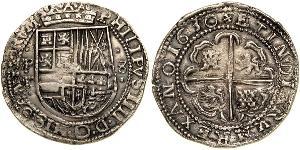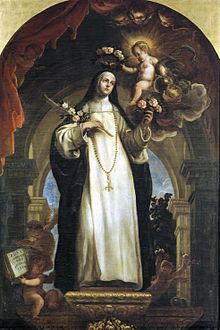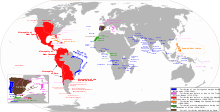| preceded by | |
|
|||||||
| Viceroyalty of Peru (1542 - 1824) | |||||||
| Viceroyalty of Peru (1542 - 1824)from the Wikipedia | Read original article |
| This article needs additional citations for verification. (January 2010) |
The Viceroyalty of Peru (Spanish: Virreinato del Perú) was a Spanish colonial administrative district, created in 1542, that originally contained most of Spanish-ruled South America, governed from the capital of Lima. The Viceroyalty of Peru was one of the two Spanish Viceroyalties in the Americas from the sixteenth to the eighteenth centuries.
However, the Spanish did not resist the Portuguese expansion of Brazil across the meridian. The Treaty of Tordesillas was rendered meaningless between 1580 and 1640 while Spain controlled Portugal. The creation of Viceroyalties of New Granada and Rio de la Plata (at the expense of Peru's territory) reduced the importance of Lima and shifted the lucrative Andean trade to Buenos Aires, while the fall of the mining and textile production accelerated the progressive decay of the Viceroyalty of Peru. Eventually, the viceroyalty would dissolve, as with much of the Spanish empire, when challenged by national independence movements at the beginning of the nineteenth century. These movements led to the formation of the modern-day countries of Peru, Chile, Colombia, Panama, Ecuador, Bolivia, Paraguay, Uruguay, Argentina, Guyana and Trinidad and Tobago in the territories that at one point or another had constituted the Viceroyalty of Peru.
Contents
History[edit]
Exploration and settlement (1542–1643)[edit]
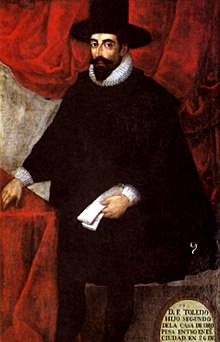

After the Spanish conquest of Peru (1532–37), the first Audiencia was constituted by Lope García de Castro (1516 - 8 January 1576), a Spanish colonial administrator that served as a member of the Council of the Indies and of the Audiencias of Panama and Lima. From September 2, 1564 to November 26, 1569 he was interim viceroy of Peru. In 1542, the Spanish created the Viceroyalty of New Castile, that shortly afterwards would be called the Viceroyalty of Peru. In 1544, Holy Roman Emperor Charles V (King Charles I of Spain) named Blasco Núñez Vela Peru's first viceroy, but the viceroyalty was not organized until the arrival of Viceroy Francisco de Toledo in 1572. Toledo made an extensive tour of inspection of the colony.
Francisco de Toledo, "one of the great administrators of human times",[1] established the Inquisition and promulgated laws that applied to both Indians and Spanish alike, breaking the power of the encomenderos and reducing the old system of mita, or forced native labor. He improved the safety in the viceroyalty with fortifications, bridges and la Armada del Mar del Sur (the Southern Fleet) against the pirates. Francisco de Toledo also ended the indigenous state of Vilcabamba, executing the Inca Túpac Amaru, and promoted economic development from the commercial monopoly and the mineral extraction, mainly, from silver mines of Potosí.
The Amazon Basin and some large adjoining regions had been considered Spanish territory since the Treaty of Tordesillas and explorations such as that by Francisco de Orellana, but the Treaty of Tordesillas was rendered meaningless between 1580 and 1640 while Spain controlled Portugal. However, Luis Jerónimo de Cabrera, 4th Count of Chinchón sent out the third expedition to explore the Amazon River, under Cristóbal de Acuña. (This was part of the return leg of the expedition of Pedro Teixeira.)
Many Pacific islands were visited by Spanish ships in the sixteenth century, but they made no effort to trade with or colonize them. These included New Guinea (by Yñigo Ortiz de Retez in 1545), and the Solomon Islands (in 1568) and the Marquesas Islands (in 1595) by Álvaro de Mendaña de Neira.
The first Jesuit reduction to Christianize the Indigenous population was founded in 1609, but some areas were occupied by Brazilians as Bandeirantes gradually extended their activities throughout much of the basin and adjoining Mato Grosso in the 17th and 18th centuries. These groups had the advantage of remote geography and river access from the mouth of the Amazon (which was in Portuguese territory). Meanwhile the Spanish were barred by their laws from slaving of indigenous people, leaving them without a commercial interest deep in the interior of the basin.[2]
One famous attack upon a Spanish mission in 1628 resulted in the enslavement of 60,000 indigenous people.[3] In fact as time passed they were used as a self funding occupation force by the Portuguese authorities in what was effectively a low level war of territorial conquest.
In 1617, Francisco de Borja y Aragón divided the government of Río de la Plata into two, Buenos Aires and Paraguay, both dependencies of the Viceroyalty of Peru. Viceroy Borja y Aragón also established the Tribunal del Consulado, a special court and administrative body for commercial affairs in the viceroyalty. Diego Fernández de Córdoba, Marquis of Guadalcázar reformed the fiscal system and stopped the interfamily rivalry that was bloodying the domain.
Other viceroys, such as Fernando Torres, Borja y Aragón, Fernández de Cabrera or Fernández Córdoba also expanded the colonial navy and fortified the ports to fight against pirate attacks, as those led by the Englishman Thomas Cavendish. Fernández de Cabrera suppressed an insurrection of the Uru and Mapuche Indians.
The last Spanish Habsburgs (1643–1713)[edit]

Viceroys had to protect the Pacific coast from French contraband and English and Dutch pirates. They expanded the naval forces, fortified the ports of Valdivia, Valparaíso, Arica and Callao and constructed city walls in Lima (1686) and Trujillo (1685–1687). Nevertheless, the famous English privateer Henry Morgan took Chagres and captured and sacked the city of Panama in the early part of 1670. Also Peruvian forces repelled the attacks by Edward David (1684 and 1686), Charles Wager and Thomas Colb (1708) and Woldes (1709–1711). The Peace of Utrecht allowed the British to send ships and merchandise to the fair at Portobello.
In this period, revolts were common. Around 1656, Pedro Bohórquez crowned himself Inca (emperor) of the Calchaquí Indians, inciting the indigenous population to revolt. From 1665 until 1668, the rich mineowners José and Gaspar Salcedo revolted against the colonial government. The clergy were opposed to the nomination of prelates from Spain. Viceroy Diego Ladrón de Guevara had to take measures against an uprising of slaves at the hacienda of Huachipa de Lima. There were terrible earthquakes (1655, 1687) and epidemics, too.
During Baltasar de la Cueva Enríquez's administration, the laws of the Indies were compiled.[4] Diego de Benavides y de la Cueva issued the Ordenanza de Obrajes (Ordenance of Manufactures) in 1664 and Pedro Álvarez de Toledo y Leiva introduced the papel sellado (literally, sealed paper). In 1683 Melchor de Navarra y Rocafull reestablished the Lima mint, which had been closed since 1572. Viceroy Diego Ladrón de Guevara increased the production of silver in the mines of Potosí, and stimulated production in other mines at San Nicolás,[disambiguation needed] Cajatambo and Huancavelica. He limited the manufacture of aguardiente from sugar cane to authorized factories, which he taxed heavily.
The Churches of Los Desamparados (1672), La Buena Muerte and the convent of Mínimos de San Francisco de Paula were finished and opened. The Hospital of Espiritu Santo in Lima and San Bartolomé hospital were built.
The Bourbon Reforms (1713–1806)[edit]
In 1717 the Viceroyalty of New Granada was created from the northern territories, the Audiencias of Bogotá, Quito and Panamá. This viceroyalty initially lasted only until 1724, but was reestablished permanently in 1740. With the creation of the Viceroyalty of the Río de la Plata from southern areas that are now Argentina, Bolivia, Paraguay and Uruguay in 1776, the Charcas and Buenos Aires audiencias were similarly lost. The 256-year-old Treaty of Tordesillas was superseded by the 1750 Treaty of Madrid which granted Portugal control of the lands it had occupied in South America in the intervening centuries. This Portuguese occupation led to the Guaraní War of 1756.
-
1534
Brazil according to the Treaty of Tordesillas -
1789
Brazil according to the Treaty of Madrid (1750)
Several viceroys had scientific, political and economic impact on the Viceroyalty. Manuel de Amat y Juniet organized an expedition to Tahiti. Viceroy Teodoro de Croix also decentralized the government through the creation of eight intendencias in the area of the Audiencia of Lima, and two in the Captaincy General of Chile. Francisco Gil de Taboada reincorporated the region of Puno into the Viceroyalty of Peru. José de Armendáriz stimulated the production of silver and took steps against fraud, corruption and smuggling. Amat y Juniet established the first Regulation of Commerce and Organization of Customs rules, which led to the building of the customshouse in Callao.[5] Teodoro de Croix collaborated in the creation of the Junta Superior de Comercio and the Tribunal de Minería (1786).
An earthquake demolished Lima and Callao, in 1746. Viceroy Amat y Juniet constructed various public works in Lima, including the first bull ring. Manuel de Guirior also improved the medical care at ten hospitals in Lima and established a foundling home.
War between Spain and Britain again broke out (the War of Jenkins' Ear, 1739–1748). Amat y Juniet constructed the fortress of Real Felipe in Callao in 1774.
Nevertheless, throughout this period, the Native peoples were not entirely suppressed. In the eighteenth century alone, there were fourteen large uprisings, the most important of which were that of Juan Santos Atahualpa in 1742, and the Sierra Uprising of Túpac Amaru II in 1780. The Comunero Revolt broke out in Paraguay from 1721 to 1732). In 1767, the Jesuits were expelled from the colony.
End of the Viceroyalty (1806–1824)[edit]
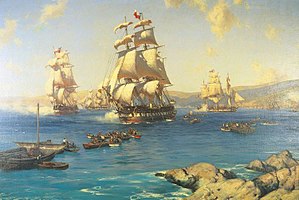
Viceroy José Fernando de Abascal y Sousa promoted educational reforms, reorganized the army, and stamped out local rebellions. During his administration, the Inquisition of Lima was temporarily abolished as a result of the reforms taken by the Cortes in Spain.
When the wars of independence broke out in 1810, Peru was the center of Royalist reaction. Abascal reincorporated the provinces of Córdoba, Potosí, La Paz, Charcas, Chile and Quito (Ecuador) into the Viceroyalty of Peru. The Royal Army of Perú during 14 years defeated the patriots armies of Argentinians and Chileans, turning Peru into the last royal bastion in South America.
In 1812 occurred the great fire of Guayaquil that destroyed half the city.
Lord Cochrane, in command of the newly created Chilean Navy, unsuccessfully attacked Guayaquil and El Callao, but on 4 February he captured Valdivia, called at the time The Key of the South Seas and the Gibraltar of the Pacific, due to its huge fortifications. However the viceroyalty managed to defend Chiloé Island until 1826.
On September 8, 1820, the Expedición Libertadora of Peru, organized mainly by Argentinians and with some Peruvian and Chilean involvement, landed on the beach at Paracas Bay, near the city of Pisco, Peru. The army was under the command of José de San Martín. After fruitless negotiations with the viceroy, San Martín occupied the Peruvian capital of Lima on July 21, 1821. The independence of Peru was proclaimed on July 28, 1821. Viceroy José de la Serna e Hinojosa, still in command of a sizable military force, retired to Jauja, and later to Cusco.
On July 26, 1822, San Martín and Simón Bolívar met in Guayaquil to define a strategy for the liberation of the rest of Peru. The meeting was secret, and exactly what occurred is not known. However, afterwards San Martín returned to Argentina while Bolívar prepared to launch an offensive against the remaining royalist forces in Peru and Upper Peru (Bolivia). In September 1823 Bolívar arrived in Lima with Antonio José de Sucre to plan the offensive.
In February 1824 the royalists briefly regained control of Lima. Olañeta's Rebellion started by surprise and the entire royalist army of Upper Peru (today's Bolivia) revolted, led by Pedro Antonio Olañeta (royalist) against La Serna, the viceroy of Peru (a liberal). This broke the royal army and started a civil war in Upper Peru. Having regrouped in Trujillo, Bolívar in June led his rebel forces south to confront the Spanish under Field Marshal José de Canterac. The two armies met on the plains of Junín on August 6, 1824, and the Peruvians were victorious in a battle fought entirely without firearms. The Spanish troops subsequently evacuated Lima for a second time.
As a result of a decree of the Congress of Gran Colombia, Bolívar turned over command of the rebel troops to Sucre on October 7, 1824.
Royalist control was now reduced to Cuzco in the south-central highlands. The viceroy launched a counter-offensive over Ayacucho. It was there that the final battle for the independence of Peru would be fought.
On 9 December 1824, the Battle of Ayacucho, or Battle of La Quinua, took place at Pampa de La Quinua, a few kilometers away from Ayacucho, near the town of Quinua. This battle — between royalist (Spanish) and nationalist (republican) troops — sealed the independence of Peru and South America. The victorious nationalist forces were led by Antonio José de Sucre, Bolívar's lieutenant. Viceroy Serna was wounded and taken prisoner. The Spanish army had 2,000 dead and wounded and lost 3,000 prisoners, with the remainder of the army entirely dispersed. After the battle, Serna signed the final capitulation whereby the Spaniards agreed to leave Peru. Serna was released soon afterwards and sailed for Europe.
Spain made futile attempts to retain its former colonies, such as at the Siege of Callao (1826), but after death of King Ferdinand VII of Spain, in 1836 government of Spain renounced its territorial and sovereignty claims over all of continental America. In 1867 Spain signed a peace treaty with Peru and in 1879 it signed a treaty recognizing Peru's independence.
Politics[edit]

The town of Lima, founded by Pizarro on January 18, 1535 as the "Ciudad de los Reyes" (City of the Kings/Magi), became the seat of the new viceroyalty. As the seat of a viceroy, who had oversight over all of Spanish South America except for Portuguese-dominated Brazil, Lima grew into a powerful city. During the 16th, 17th and most of the 18th centuries, all of the colonial wealth of South America created by the silver mines passed through Lima on its way to the Isthmus of Panama and from there to Seville, Spain. The rest of the viceroyalty dependent upon Lima in administrative matters, in a pattern that persists until today in Peru. By the start of 18th century, Lima had become a distinguished and aristocratic colonial capital, seat of the 250-year-old Royal and Pontifical University of San Marcos and the chief Spanish stronghold in the Americas.
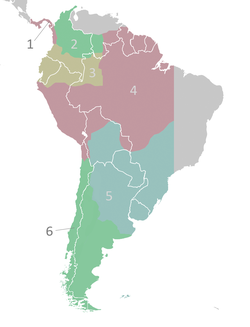
At ground level during the first century, Spanish encomenderos depended on local chieftains (curacas) to gain access to the Indian population's tribute labor, even the most remote settlements, and therefore, many encomenderos developed reciprocal, if still hierarchical, relationships with the curacas.[7] By the end of the 16th century the quasi-private encomienda had been replaced by the repartimiento system (known in Peru by the Quechua term, mita), which was controlled by local crown officials.
Politically the viceroyalty was further divided into audiencias, which were primarily superior tribunals, but which also had administrative and legislative functions. Each of these was responsible to the Viceroy of Peru in administrative matters (though not in judicial ones). Audiencias further incorporated the older, smaller divisions known as "governorships" (gobernaciones, roughly provinces) headed by a governor. (See, Adelantado.) Provinces which were under military threat were grouped into captaincies general, such as the Kingdom of Chile (established in 1541 and established as a Bourbon captaincy general in 1789), and which were joint military and political commands with a certain level of autonomy. (The viceroy was captain-general of the provinces which remained directly under his command).
At the local level there were hundreds of districts, in both Indian and Spanish areas, which were headed by either a corregidor (also known as an alcalde mayor) or a cabildo (town council), both of which had judicial and administrative powers. In the late 18th century the Bourbon dynasty began phasing out the corregidores and introduced intendants, whose broad fiscal powers cut into the authority of the viceroys, governors and cabildos. (See Bourbon Reforms.)
Audiencias[edit]
With dates of creation:
- Panamá (1st one, 1538–1543), (2nd one, 1564–1751)*
- Santa Fe de Bogotá (1548)*
- Quito (1563)*
- Lima (1543)
- La Plata de los Charcas (1559)†
- Chile (1563–1573; 1606)
Later Audiencias
- Buenos Aires (1661–1672; 1776)†
- Cuzco (1787)
*Later part of the Viceroyalty of New Granada
†Later part of the Viceroyalty of the Río de la Plata
Autonomous Captaincy General[edit]
1. Chile (1789)
Intendancies[edit]
Listed under year of creation:[8][9]
1784
3. Trujillo, 4. Tarma, 5. Huancavelica, 6. Cusco, 7. Arequipa, (10. Chiloé, abolished in 1789)
1786
8. Santiago, 9. Concepción
Economy[edit]

The economy of the viceroyalty of Peru largely revolved on the massive exports of silver.[10] The huge amounts of silver exported from the viceroyalty of Peru and Mexico had also a deep impact on Europe where it believed by some scholars to have caused the so-called "price revolution".[11] Silver mining was carried out using the mita system of unfree labour,[11] a system inherited from pre-Hispanic times. Silver production peaked in 1610.[11]
Once the Viceroyalty of Peru was established, gold and silver from the Andes enriched the conquerors, and Peru became the principal source of Spanish wealth and power in South America. The first coins minted for Peru (and indeed for South America) appeared between 1568 and 1570. Viceroy Manuel de Oms y de Santa Pau was able to send back an enormous sum of money (1,600,000 pesos) to the king to cover some of the costs of the War of the Spanish Succession. This was possible in part because of the discovery of the mines in Caraboya. The silver from mines at Potosí, Bolivia circulated around the world. Peruvian and other New World silver was so plentiful that it caused inflation in Spain and a collapse in its price. Even today, Peru and Bolivia produce much of the world's silver.
Luis Jerónimo Fernández de Cabrera prohibited direct trade between Peru and New Spain (Mexico) and the persecution of Portuguese Jews, the principal traders in Lima.
Demographics[edit]

A census taken by the last Quipucamayoc indicated that there were 12 million inhabitants of Inca Peru; 45 years later, under viceroy Toledo, the census figures amounted to only 1,100,000 Indians. While the attrition was not an organized attempt at genocide, the results were similar, largely resulting from smallpox and other Eurasian diseases to which the natives had no immunity. Inca cities were given Spanish Christian names and rebuilt as Spanish towns, each centered around a plaza with a church or cathedral facing an official residence. A few Inca cities like Cuzco retained native masonry for the foundations of their walls. Other Inca sites, like Huanuco Viejo, were abandoned for cities at lower altitudes more hospitable to the Spanish.
Viceroy José de Armendáriz reestablished the system whereby Inca nobles who could prove their ancestry were recognized as hijosdalgos of Castile. This led to a frenzy on the part of the Indigenous nobility to legitimate their status.
In the 1790s Viceroy Francisco Gil de Taboada ordered the first official census of the population.
The last cargo of black slaves in Peru was landed in 1806. At that time an adult male slave sold for 600 pesos.
Culture[edit]

Viceroy Francisco de Borja y Aragón reorganized the University of San Marcos and Luis Jerónimo Fernández de Cabrera founded two chairs of medicine. In the 1710s, Viceroy Diego Ladrón de Guevara established a chair of anatomy. Teodoro de Croix and Francisco Gil de Taboada founded anatomy centers. In 1810 the medical school of San Fernando was founded.
On the death of the Peruvian astronomer Doctor Francisco Ruiz Lozano, Viceroy Melchor Liñán y Cisneros (with the approval of the Crown) gave mathematics a permanent position in the University of San Marcos. Mathematics was attached to the chair of cosmography. Doctor Juan Ramón Koening, a Belgian by birth, was named to the chair.[2]. Viceroy Manuel de Guirior created two new chairs at the university.
Luis Enríquez de Guzmán, 9th Count of Alba de Liste founded the Naval Academy of the colony. Francisco Gil de Taboada supported the navigation school. Teodoro de Croix began the Botanic Garden of Lima.
Francisco de Borja y Aragón also founded, in Cuzco, the Colegio del Príncipe for sons of the Indigenous nobility and the Colegio de San Francisco for sons of the conquistadors. Manuel de Amat y Juniet founded the Royal College of San Carlos.
The first books printed in Peru were produced by Antonio Ricardo, a printer from Turin who settled in Lima. Diego de Benavides y de la Cueva built the first theater in Lima. Manuel de Oms y de Santa Pau founded a literary academy in 1709 and promoted weekly literary discussions in the palace that attracted some of Lima's best writers. These included the famous Criollo scholar Pedro Peralta y Barnuevo and several Indigenous poets. Oms introduced French and Italian fashions in the viceroyalty. The Italian musician Rocco Cerruti (1688–1760) arrived in Peru. Francisco Gil de Taboada supported the foundation of the newspaper El Mercurio Peruano in 1791 and founded the Academy of Fine Arts.
Jesuit Barnabé de Cobo (1582–1657), who explored Mexico and Peru, brought the cinchona bark from Lima to Spain in 1632, and afterwards to Rome and other parts of Italy.
In 1671, Saint Rose of Lima was canonized by Pope Clement X. Rose was the first native-born American to become a Catholic saint. Pope Benedict XIII elevated another two important Peruvian saints, Toribio Alfonso de Mogrovejo and Francisco de Solano.
Diego Quispe Tito was a famous artist before the age of Independence.
Science[edit]
In 1737 Jorge Juan y Santacilia and Antonio de Ulloa, Spanish scientists sent by the French Academy on a scientific mission to measure a degree of meridian arc at the equator, arrived in the colony. They also had the mission of reporting on disorganization and corruption in the government and smuggling. Their report was published later, under the title Noticias Secretas de América (Secret News From America).
Manuel de Guirior assisted the scientific expedition of Hipólito Ruiz López, José Antonio Pavón and Joseph Dombey, sent to study the flora of the viceroyalty. The expedition lasted from 1777 to 1788. Their findings were later published as La flora peruana y chilena (The Flora of Peru and Chile). Again a major concern was stimulating the economy, which Guirior did by adopting liberal measures in agriculture, mining, commerce and industry.
Another French influence on science in the colony was Louis Godin, another member of the meridian expedition. He was appointed cosmógrafo mayor by Viceroy Mendoza.[3] The duties of cosmógrafo mayor included publishing almanacs and sailing instructions. Another French scientist in Peru at this time was Charles Marie de La Condamine.
The Balmis Expedition arrived in Lima on May 23, 1806. At the same time these viceroys adopted rigorous measures to suppress the thought of the Encyclopedists and revolutionaries in the United States and France.
See also[edit]
- Peruvian Viceroyal architecture
- Inca architecture
- Colonialism
- List of Viceroys of Peru
- Spanish colonization of the Americas
- Spanish Empire
- Viceroyalty of New Spain
References[edit]
- ^ Mabry, Donald J., Colonial Latin America. Coral Springs, Fla.: Llumina Press, 2002.
- ^ The Laws of Burgos (1512) and the New Laws (1542) had been intended to protect the interests of indigenous people. While in spirit they were often abused, as through forced exploitative labour of locals, they did prevent widespread formal enslavement of indigenous people in Spanish territories. Renegade slavers, operating illegally in Spanish territory, did so as agents of the Portuguese slave markets in Brazil.
- ^ An early bandeira in 1628, led by Antônio Raposo Tavares), composed of 2,000 allied Indians, 900 Mamluks (Mestizos) and 69 white Paulistanos, to find precious metals and stones and / or to capture Indians for slavery. This expedition alone was responsible for the destruction of most of the Jesuit missions of Spanish Guairá and the enslavement of over 60.000 indigenous people. In response the missions that followed were militarized.
- ^ Follow this link.
- ^ [1]
- ^ For two, somewhat different interpretations of the boundaries in unsettled areas, see Burkholder, Mark A. and Lyman L. Johnson. Colonial Latin America (10 editions). (New York: Oxford University Press, 1990), Map 2, 73 ISBN 0-19-506110-1; and Lombardi, Cathryn L., John V. Lombardi and K. Lynn Stoner. Latin American History: A Teaching Atlas. (Madison: The University of Wisconsin Press, 1983), 29. ISBN 0-299-09714-5
- ^ Steve Stern. “The Rise and Fall of Indian-White Alliances: a Regional View of ‘Conquest’ History,” Hispanic American Historical Review, 61:3 (1981), 461-491
- ^ Harding, C. H., The Spanish Empire in America. (New York: Oxford University Press, 1947), 133-135
- ^ Lombardi, Cathryn L., John V. Lombardi and K. Lynn Stoner, Latin American History: A Teaching Atlas. (Madison: University of Wisconsin Press, 1983), 50. ISBN 0-299-09714-5
- ^ Viceryoalty of Peru, Encycloepdia Britannica. Academic edition. 2011.
- ^ a b c Garner, Richard L. Long-Term Silver Mining Trends in Spanish America: A Comparative Analysis of Peru and Mexico
External links[edit]
| Wikimedia Commons has media related to Viceroyalty of Perú (Virreinato del Perú). |
|
|
||||||
- Metropolitan Museum of Art Libraries.org: "The colonial Andes: tapestries and silverwork, 1530-1830" — exhibition catalog with info on the Viceroyalty of Peru (available online as PDF).
|
||||||||||||
|
||||||||||||||||||||||||||||||||
|
||||||||||||||||||||||||||||||||||||||||||||
- Former monarchies of South America
- Former countries in South America
- States and territories established in 1542
- States and territories disestablished in 1824
- Viceroyalty of Peru
- Viceroyalties of the Spanish Empire
- Colonial Peru
- Colonial Chile
- Colonial Colombia
- Former colonies in South America
- History of Peru
- History of South America
- Spanish colonization of the Americas
- 16th century in Peru
- 17th century in Peru
- 18th century in Peru
- 1800s in Peru
- 1810s in Peru
- 1820s in Peru
- 16th-century establishments in Spain
- Titles of nobility in the Americas

